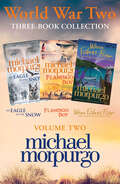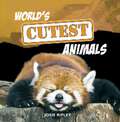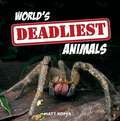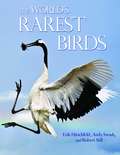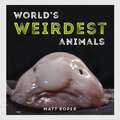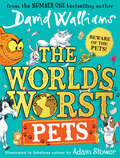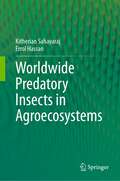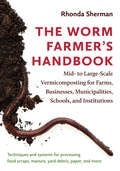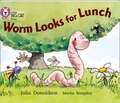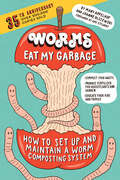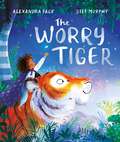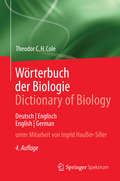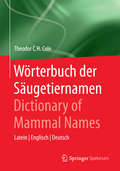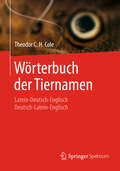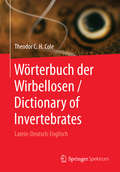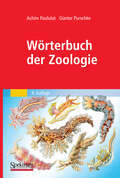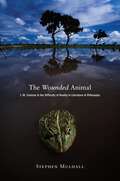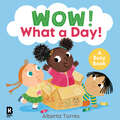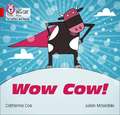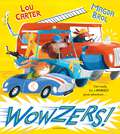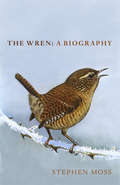- Table View
- List View
World War Two Collection: An Eagle In The Snow, Flamingo Boy, When Fishes Flew
by Michael MorpurgoAn ebook collection of three of master storyteller Michael Morpurgo’s Second World War novels.
World's Cutest Animals
by Josie RipleyPocket-sized gophers, fuzzy finger-monkeys and cuddly koalas are just a few of the loveable creatures you’ll find in this book. From the teeniest to the fluffiest, this collection of the world’s cutest animals contains lavish photographs, interesting facts and ‘snuggle ratings’ for Nature’s most adorable creatures.
World's Deadliest Animals
by Matt RoperMan-eating maggots, poisonous birds and fish with teeth as big as a tiger’s are just a few of the dangerous creatures you’ll encounter in this book. From tiny terrors to raging beasts, this collection of the world’s deadliest animals contains amazing photographs, gruesome descriptions and shocking stats on monsters of the natural world.
The World's Rarest Birds
by Erik Hirschfeld Andy Swash Robert StillThis illustrated book vividly depicts the most endangered birds in the world and provides the latest information on the threats each species faces and the measures being taken to save them. Today, 571 bird species are classified as critically endangered or endangered, and a further four now exist only in captivity. This landmark book features stunning photographs of 500 of these species--the results of a prestigious international photographic competition organized specifically for this book. It also showcases paintings by acclaimed wildlife artist Tomasz Cofta of the 75 species for which no photos are known to exist. The World's Rarest Birds has introductory chapters that explain the threats to birds, the ways threat categories are applied, and the distinction between threat and rarity. The book is divided into seven regional sections--Europe and the Middle East; Africa and Madagascar; Asia; Australasia; Oceanic Islands; North America, Central America, and the Caribbean; and South America. Each section includes an illustrated directory to the bird species under threat there, and gives a concise description of distribution, status, population, key threats, and conservation needs. This one-of-a-kind book also provides coverage of 62 data-deficient species.
World's Weirdest Animals
by Matt RoperIt seems as though some creatures have been put on this earth just to amaze us. From the harmless but hilarious to the truly frightening and deadly, the animals in this book are guaranteed to keep you enthralled, astonished and extremely amused.
Worldwide Predatory Insects in Agroecosystems
by Kitherian Sahayaraj Errol HassanThis book brings out the world record of various predatory insects and their role in pestiferous insect management in a safer manner. The main focus of the book is to address the ecological and environmentally safe methods of managing pests of various crops. The utilization of various types of chemical pesticides for our crop protection and food production leads to environmental concerns and health hazards to plants and animals. This book mainly focuses on the distribution and diversity of various predatory insects in different crops. It also sellout the bionomics, biological control potential at a laboratory, controlled fields and natural conditions. Moreover, mass production technology and environmental safety aspects are also highlighted in various chapters. This book is of interest and useful to undergraduates, post-graduates, research scholars and doctoral candidates, extension workers, and agricultural professionals, and also a valuable source of reference to the relevant researchers and students in the region.
The Worm Farmer’s Handbook: Mid- to Large-Scale Vermicomposting for Farms, Businesses, Municipalities, Schools, and Institutions
by Rhonda ShermanTechniques and systems for processing food scraps, manure, yard debris, paper, and more Turning waste into wealth sounds too good to be true, but many worm farmers are finding that vermicomposting is a reliable way to do just that. Vermicast—a biologically active, nutrient-rich mix of earthworm castings and decomposed organic matter—sells for $400 or more per cubic yard. Compare that to regular compost, sold at about $30 a cubic yard, and you’ll see why vermicomposting has taken root in most countries and on every continent but Antarctica. Vermicomposting is also one of the best sustainable solutions for organic waste management. Vermicomposting manure and crop wastes on farms improves crop yields while reducing demand for off-farm inputs. Vermicast has higher nutrient levels and lower soluble salt content than regular compost, and it improves soil aeration, porosity, and water retention. Plus, vermicast suppresses plant diseases and insect attacks. Municipalities, businesses, community gardens, schools, and universities can set up vermicomposting operations to process food residuals and other waste materials. The Worm Farmer’s Handbook details the ins and outs of vermicomposting for mid- to large-scale operations, including how to recycle organic materials ranging from food wastes and yard trimmings to manure and shredded office paper. Vermicomposting expert Rhonda Sherman shares what she has learned over twenty-five years working with commercial worm growers and researchers around the world. Her profiles of successful worm growers across the United States and from New Zealand to the Middle East and Europe describe their proven methods and systems. This book digs into all the details, including: Choosing the right production system Regulatory issues and developing a business and marketing plan Finding and managing feedstocks Pre-composting: why and how to do it Monitoring an active worm bed Harvesting, screening, testing, packaging, and storing vermicast Markets for earthworms and vermicast Food security: how vermicast benefits soils and plants Keys to success: avoiding common pitfalls From livestock farms and restaurants to colleges, military bases, and prisons, Sherman details why and how commercial-scale vermicomposting is a fast-growing, sustainable solution for organic waste management. The Worm Farmer’s Handbook is the first and only authoritative how-to guide that goes beyond small-scale operations and demystifies the science and logistics of the fascinating process that is vermicomposting.
Worm Looks For Lunch: Band 05/green (Collins Big Cat Ser.)
by Julia Donaldson Martin Remphrey Cliff Moon Collins Big CatWorm is fed up with earth for lunch and wants something more exciting. He tries eating grass, bark and even a leaf on the advice of various animal friends - and almost becomes lunch himself when a hungry bird appears! Green/ Band 5 books offer early readers patterned language and varied characters. Text type - Playscript. Instructions for putting on the play are on pages 22 and 23 to encourage children to discuss the script. Curriculum links - Science: Plants and animals in the local environment. This book has been levelled for Reading Recovery. This book has been quizzed for Accelerated Reader.
Worms Eat My Garbage, 35th Anniversary Edition: How to Set Up and Maintain a Worm Composting System: Compost Food Waste, Produce Fertilizer for Houseplants and Garden, and Educate Your Kids and Family
by Mary Appelhof Joanne OlszewskiFor more than three decades, this best-selling guide to the practice of vermicomposting has taught people how to use worms to recycle food waste into nutrient-rich fertilizer for houseplants or gardens. Small-scale, self-contained worm bins can be kept indoors, in a basement, or even under the kitchen sink in an apartment — making vermicomposting a great option for city dwellers and anyone who doesn&’t want or can&’t have an outdoor compost pile. The fully revised 35th anniversary edition features the original&’s same friendly tone, with up-to-date information on the entire process, from building or purchasing a bin (readily available at garden supply stores) to maintaining the worms and harvesting the finished compost.
The Worry Tiger
by Alexandra PageA mindfulness storybook that weaves calming actions into a magical story, showing young children ways to soothe their own worries.From the creators of The Fire Fox, Alexandra Page and Stef Murphy, shortlisted for Oscar's Book Prize 2022.It's show-and-tell tomorrow and Rory is anxious – he doesn't have anything special to share with the class. But everything changes when Rory meets his very own worry tiger."Try this," said the tiger. "See how quiet you can be. Tiptoe like a tiger and tell me what you see."Breathing deep to smell the jungle scents.Stretching to join the monkeys high up in the trees.Listening carefully to the creatures all around.This enchanting story is full of mindfulness actions that anyone can take to feel calm.The Worry Tiger is a gorgeously illustrated book with a gentle rhyme that's a joy to read aloud and will help children relax and speak about what might be feeding their anxiety.Includes a set of fun and easy mindfulness exercises at the back of the book.
Wörterbuch der Biologie Dictionary of Biology: Deutsch/Englisch English/German
by Theodor C.H. ColeDas Wörterbuch der Biologie ... kompetent, zuverlässig, bewährt! Das Standardwerk Wörterbuch der Biologie nun in 4. aktualisierter und erweiterter Auflage, mit ca. 60.000 Begriffen. Das führende deutsch-englische Fachwörterbuch in den Life Sciences – die essenzielle Sprach- und Übersetzungshilfe.Thematische Wortfelder verschaffen einen klaren Überblick bei der Recherche und Übersetzung.Alle Fachbereiche der Biologie und angrenzender Wissenschaften sind berücksichtigt:Anatomie/MorphologieBioanalytikBiochemieBiogeographieBiomedizinBiostatistik/BiometrieBiotechnologieBodenkundeEntwicklungsbiologieEvolutionForstwirtschaftGenetikHistologieImmunologieKlimatologieLaborLandwirtschaft/GartenbauMeeresbiologie/LimnologieMikroskopieMolekularbiologieNatur & UmweltNeurowissenschaftenÖkologiePaläontologie/ErdgeschichteParasitologiePharmazeutische BiologiePhysiologieSystematik/PhylogenieVerhaltenslehreZellbiologie
Wörterbuch der Säugetiernamen - Dictionary of Mammal Names: Latein - Englisch - Deutsch
by Theodor C.H. ColeDas Wörterbuch der Säugetiernamen enthält die wissenschaftlichen, deutschen und englischen Namen aller in der IUCN Red List von 2008 aufgeführten rezenten Säugetierarten sowie einige neuentdeckte oder einer taxonomischen Revision unterzogene Arten – alphabetisch nach derzeit gültigen wissenschaftlichen Namen geordnet. Für die Mehrzahl der Arten sind in jeder Sprache mehrere gebräuchliche Trivialnamen aufgeführt.
Wörterbuch der Tiernamen: Latein-Deutsch-Englisch Deutsch-Latein-Englisch
by Theodor C. ColeDas umfassende und zuverlässige Nachschlagewerk für Tiernamen - von Aal bis Zylinderrose - alles in einem Band Sie möchten wissen, wie die Gartenhummel oder das Breitmaulnashorn auf Englisch heißen? Wer ist Zeus faber, Ia io oder Naja naja? Sie interessiert, welches Tier sich hinter noodlefish oder waterdog verbirgt? Dieses Buch enthält die Namen von mehr als 16.000 Tieren aus Europa und der ganzen Welt in lateinischer, deutscher und englischer Sprache. Seit "Grzimek" ist dies die erste aktuelle und umfassende Liste häufiger und gefährdeter Tiere. Coles Wörterbuch umfasst die wissenschaftlich korrekten lateinischen Bezeichnungen und international geläufigen englischen Begriffe ebenso wie Trivialnamen und Synonyme. Sie finden die wichtigsten Tiere aus Landwirtschaft und Tierhandel, dem Lebensmittelsektor, der Aquaristik, aus Zoos und Wildparks sowie Tiere, die für Ornithologen, Taucher, Kleintierzüchter, Pelzhändler und Jäger von Bedeutung sind. Wer die Tiere beim Namen nennen will, braucht dieses Buch.
Wörterbuch der Wirbellosen / Dictionary of Invertebrates: Latein-Deutsch-Englisch
by Theodor C. ColeDas Wörterbuch der Wirbellosen umfasst die Mehrzahl der in den deutschsprachigen Gebieten Europas vorkommenden wirbellosen Tiere, für die bereits Trivialnamen existieren. Darüber hinaus ist eine Vielzahl wichtiger globaler Arten aufgeführt. Die Namen der hier gelisteten 12.800 wirbellosen Tiere sind geordnet nach Großgruppen und darin jeweils alphabetisch nach wissenschaftlichen Namen – ergänzt durch deren englische Trivialnamen, soweit vorhanden. Zu Grunde liegt eine umfangreiche Literaturbearbeitung enzyklopädischer Werke, Faunen, Naturführer, Roter Listen und Monographien einzelner Tiergruppen. Dieses Referenz- und Nachschlagewerk ist nicht nur hilfreich und wichtig für Wissenschaftler, Übersetzer und Journalisten, sondern auch für all diejenigen, die sich auf verschiedenste Art und Weise mit Tieren beschäftigen.
Wörterbuch der Zoologie: Tiernamen, allgemeinbiologische, anatomische, physiologische, ökologische Termini
by Achim Paululat Günter PurschkeDieses konkurrenzlose Nachschlagewerk hat sich im Laufe der Jahre als zuverlässige Informationsquelle für Zoologen und an Zoologie Interessierte erwiesen. Das nun in der 7. Auflage umfassend überarbeitete Wörterbuch gibt in nunmehr 16.500 (!!) Stichwörtern präzise Auskunft über alle wichtigen bzw. häufig vorkommenden Tiernamen und einschlägigen Fachwörter. Es ist im deutschsprachigen Europa das einzige dieser Art und zeichnet sich aus durch hohe Informationsdichte, überschaubare Gliederung und den Querschnittscharakter der aufgenommenen Stichwörter.
The Wounded Animal: J. M. Coetzee and the Difficulty of Reality in Literature and Philosophy
by Stephen MulhallIn 1997, the Nobel Prize-winning novelist J. M. Coetzee, invited to Princeton University to lecture on the moral status of animals, read a work of fiction about an eminent novelist, Elizabeth Costello, invited to lecture on the moral status of animals at an American college. Coetzee's lectures were published in 1999 as The Lives of Animals, and reappeared in 2003 as part of his novel Elizabeth Costello; and both lectures and novel have attracted the critical attention of a number of influential philosophers--including Peter Singer, Cora Diamond, Stanley Cavell, and John McDowell. In The Wounded Animal, Stephen Mulhall closely examines Coetzee's writings about Costello, and the ways in which philosophers have responded to them, focusing in particular on their powerful presentation of both literature and philosophy as seeking, and failing, to represent reality--in part because of reality's resistance to such projects of understanding, but also because of philosophy's unwillingness to learn from literature how best to acknowledge that resistance. In so doing, Mulhall is led to consider the relations among reason, language, and the imagination, as well as more specific ethical issues concerning the moral status of animals, the meaning of mortality, the nature of evil, and the demands of religion. The ancient quarrel between philosophy and literature here displays undiminished vigor and renewed significance.
The Wounded Animal: J. M. Coetzee and the Difficulty of Reality in Literature and Philosophy
by Stephen MulhallIn 1997, the Nobel Prize-winning novelist J. M. Coetzee, invited to Princeton University to lecture on the moral status of animals, read a work of fiction about an eminent novelist, Elizabeth Costello, invited to lecture on the moral status of animals at an American college. Coetzee's lectures were published in 1999 as The Lives of Animals, and reappeared in 2003 as part of his novel Elizabeth Costello; and both lectures and novel have attracted the critical attention of a number of influential philosophers--including Peter Singer, Cora Diamond, Stanley Cavell, and John McDowell. In The Wounded Animal, Stephen Mulhall closely examines Coetzee's writings about Costello, and the ways in which philosophers have responded to them, focusing in particular on their powerful presentation of both literature and philosophy as seeking, and failing, to represent reality--in part because of reality's resistance to such projects of understanding, but also because of philosophy's unwillingness to learn from literature how best to acknowledge that resistance. In so doing, Mulhall is led to consider the relations among reason, language, and the imagination, as well as more specific ethical issues concerning the moral status of animals, the meaning of mortality, the nature of evil, and the demands of religion. The ancient quarrel between philosophy and literature here displays undiminished vigor and renewed significance.
Wow! – Wow! What a Day! (Wow!)
by HarperCollins Children’s BooksThe Wow! books are a series of modern first concept books for today’s children! The books put little ones in the centre of the action with relatable experiences that will help foster inclusivity, empathy and discussion. Illustrated by Alberta Torres, illustrator of This Little picture book series.
Wow Cow!: Band 02B/Red B (PDF)
by Catherine Coe Illustrated by Julian Mosedale Prepared for publication by Collins Big CatThe goats on Hill Farm have a problem – someone is stealing their food. They need the help of Wow Cow and they need it fast, but will she uncover the culprit? Red B/Band 2B books offer simple but varied text with familiar objects and actions, combined with simple story development and a satisfying conclusion.
WOW! It's Night-time
by Tim HopgoodStep into a night-time world with Tim Hopgood, creator of the bestselling WOW! Said the Owl in WOW It's Night-time! The curious little owl is back, and this time she’s ready to discover the wonders of night-time, from the big, bright moon to the bats in the sky and the foxes deep in the forest. But where are all the other owls? When the wind blows the leaves from her tree, you'll soon see . . .A perfect preschool introduction to the nocturnal world with something to count on every page – all the way from one to ten! A timeless book told with warmth and simplicity, perfect for sharing at bedtime.Discover more from Tim Hopgood: WOW! Said the Owl, TIP TAP Went the Crab, Hooray for Hoppy and Walter's Wonderful Web
WOW! Said the Owl: A First Book of Colours
by Tim HopgoodAt night, when we are feeling tired and ready for bed, owls are just waking up. But this curious little owl decides to stay awake all day, instead of all night, and discovers a world bursting with colour! But when the night-time comes around again, the stars above her head are still the most beautiful sight of all.WOW! Said the Owl is an engaging book about colours from Tim Hopgood, the winner of the Best Emerging Illustrator, Booktrust Early Years Award.
Wowzers!
by Mrs Lou CarterRabbit is desperate to buy a new car . . . until one fine day, he finally saves up enough for his heart's desire. VROOM! But when Rabbit sees his friends showing off their cool diggers and flashing fire-engines and amazing sailboats, it's hard to resist trying to outdo them all . . . Get ready to race off on a hilarious adventure, all about the value of friendship and helping others. It's perfect for reading (and laughing!) out loud.
The Wren: A Biography
by Stephen MossFrom the bestselling author of The Robin: A BiographyThe wren is a paradox of a bird. On the one hand wrens are ubiquitous. They are Britain’s most common bird, with 8.5 million breeding pairs and have by far the loudest song in proportion to their size. They also thrive up and down Britain and Ireland: from the smallest city garden to remote offshore islands, blustery moors to chilly mountains. Yet many people, particularly a younger generation, are not sure if they have ever seen a wren. Perhaps because the wren is so tiny, weighing just as much as two A4 sheets of paper, and so busy, always on the move, more mouse than bird. However if we cast our eyes back to recent history wrens were a mainstay of literary, cultural and popular history. The wren was on postage stamps and the farthing, it featured in nursery rhymes and greetings cards, poems and rural ‘wren hunts’, still a recent memory in Ireland particularly. With beautiful illustrations throughout, this captivating year-in-the-life biography reveals the hidden secrets of this fascinating bird that lives right on our doorstep.PRAISE FOR STEPHEN MOSS: 'A superb naturalist and writer' Chris Packham'Inspired, friendly and blessed with apparently limitless knowledge' Peter Marren'Moss has carved out an enviable niche as a chronicler of the natural world' Daily Mail
Wren (Large Print)
This is an image of a wren (called a winter wren in North America) viewed from the side and facing left so that only one eye and one wing can be found. There is a locator dot shown, which will be at the top left of the page when the image is the right way up. The wren is a very small brown bird in the centre of the page. Its head is on the left of the image with its open brown beak on the left and one of its eyes slightly to the right with a white horizontal marking above it. One of its wings is down and right and above this its erect tail.The wren's two pink legs and feet are at the bottom of the image. Each has three toes pointing to the left and one to the right.
